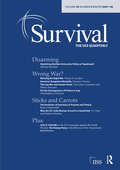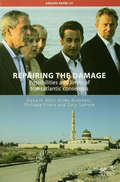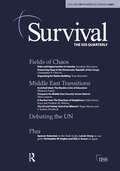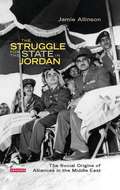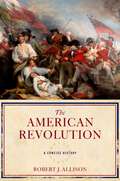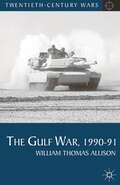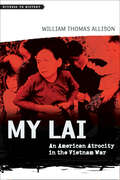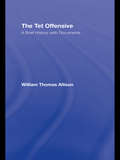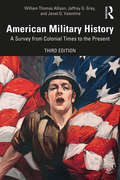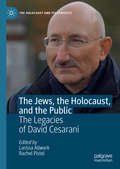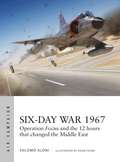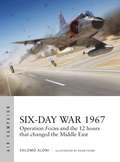- Table View
- List View
Survival 49.4: Survival 49.4, Winter 2007
by Dana AllinSurvival, the Institute of Strategic Studies' quarterly journal, is a leading forum for analysis and debate of international and strategic affairs. With a diverse range of authors, eight to ten articles per issue, plus thoughtful reviews and review essays, Survival is scholarly in depth while vivid, well-written and policy-relevant in approach. Shaped by its editors to be both timely and forward-thinking, the journal encourages writers to challenge conventional wisdom and bring fresh, often controversial, perspectives to bear on the strategic issues of the moment.
NATO's Balkan Interventions (Adelphi series #347)
by Dana H. AllinExamines NATO's Balkan interventions over the entire decade starting with the break-up of Yugoslavia in 1992. Focusing on the wars in Bosnia and Kosovo, it traces the record of early transatlantic failures and later successes as once bitterly divided allies were able, finally, to unite around some basic principles. By the time of the Kosovo intervention in spring 1999, the allies agreed on the necessity of taking sides and using military force in conflicts that were complicated, but far from morally opaque. The book concludes with some lessons around which the transatlantic allies might reasonably hope - despite other pressing concerns - to stay engaged and stay united.
NATO's Balkan Interventions (Adelphi series)
by Dana H. AllinExamines NATO's Balkan interventions over the entire decade starting with the break-up of Yugoslavia in 1992. Focusing on the wars in Bosnia and Kosovo, it traces the record of early transatlantic failures and later successes as once bitterly divided allies were able, finally, to unite around some basic principles. By the time of the Kosovo intervention in spring 1999, the allies agreed on the necessity of taking sides and using military force in conflicts that were complicated, but far from morally opaque. The book concludes with some lessons around which the transatlantic allies might reasonably hope - despite other pressing concerns - to stay engaged and stay united.
Repairing the Damage: Possibilities and Limits of Transatlantic Consensus (Adelphi series)
by Dana H. Allin Gilles Andréani Gary Samore Philippe ErreraThe damage that has been done to the transatlantic alliance will not be repaired through grand architectural redesigns or radical new agendas. Instead, the transatlantic partners need to restore their consensus and cooperation on key security challenges with a limited agenda that reflects the essential conservatism of the transatlantic partnership during the Cold War and the 1990s. There will inevitably be big challenges, such as the rise of China, where transatlantic disparities in strategic means and commitments preclude any common alliance undertaking. Yet such limits are nothing new. The absence of a common transatlantic commitment to counter-insurgency in Iraq may cause resentments, but so too did the lack of a common commitment to counter-insurgency in Vietnam. This Adelphi Paper suggests ten propositions for future transatlantic consensus – that is to say, ten security challenges for which the allies should be able to agree on common strategies. These run the gamut from an effective strategy to prevent Iran from developing a nuclear weapons capability to transatlantic leadership for international cooperation against global warming. If pursued with seriousness and a reasonable degree of transatlantic unity, these propositions could constitute the foundations of an effective partnership. They are, in the authors’ view, the basis for a consensus on the most pressing security challenges of the twenty-first century. The time is right for this kind of serious rededication to alliance purposes. There has already been some effort to repair the damage; moreover, new leaders are in place or coming to the countries that were major protagonists of the transatlantic crisis: Germany, France, Britain and, in 2009, the United States. It is possible that these four new leaders will be better able to put the disputes of the recent past behind them. This extended essay is a guide to the possibilities, and also the limits, of a new start.
Repairing the Damage: Possibilities and Limits of Transatlantic Consensus (Adelphi series)
by Dana H. Allin Gilles Andréani Gary Samore Philippe ErreraThe damage that has been done to the transatlantic alliance will not be repaired through grand architectural redesigns or radical new agendas. Instead, the transatlantic partners need to restore their consensus and cooperation on key security challenges with a limited agenda that reflects the essential conservatism of the transatlantic partnership during the Cold War and the 1990s. There will inevitably be big challenges, such as the rise of China, where transatlantic disparities in strategic means and commitments preclude any common alliance undertaking. Yet such limits are nothing new. The absence of a common transatlantic commitment to counter-insurgency in Iraq may cause resentments, but so too did the lack of a common commitment to counter-insurgency in Vietnam. This Adelphi Paper suggests ten propositions for future transatlantic consensus – that is to say, ten security challenges for which the allies should be able to agree on common strategies. These run the gamut from an effective strategy to prevent Iran from developing a nuclear weapons capability to transatlantic leadership for international cooperation against global warming. If pursued with seriousness and a reasonable degree of transatlantic unity, these propositions could constitute the foundations of an effective partnership. They are, in the authors’ view, the basis for a consensus on the most pressing security challenges of the twenty-first century. The time is right for this kind of serious rededication to alliance purposes. There has already been some effort to repair the damage; moreover, new leaders are in place or coming to the countries that were major protagonists of the transatlantic crisis: Germany, France, Britain and, in 2009, the United States. It is possible that these four new leaders will be better able to put the disputes of the recent past behind them. This extended essay is a guide to the possibilities, and also the limits, of a new start.
Survival 49.2: Survival 49.2 Summer 2007
by Dana Allin Jeffrey Mazo Steven Simon Bruno Tertrais Ellena Jamie John BuckFirst published in 2007. This book explores the complicity of democratic states from the global North in state terrorism in the global South.
Daisy's Long Road Home (Mira Ser. #3)
by Merryn AllinghamAll she’s ever wanted is a place to call home 1948: Daisy Driscoll is working as a qualified Sister in Brighton. The war may be over, but Daisy’s heart is in turmoil. Abandoned in childhood and haunted by the experience of her first marriage, Daisy no longer trusts anyone.
The Girl From Cobb Street (Mira Ser.)
by Merryn AllinghamShe longed for a family of her own… Growing up in an orphanage on East London’s Cobb Street, Daisy Driscoll never felt the warm heart of home. Forging her own way in the world, determined Daisy struggles to make ends meet as the country finds itself on the brink of the Second World War.
The Nurse's War (Mira Ser. #2)
by Merryn AllinghamWorking round the clock for her country1941: As a nurse in the rubble-strewn East end of London, Daisy Driscoll is a first-hand witness to the trauma of the Second World War. All she can do during the Blitz is to protect herself – and do her best to help others survive.
The Secret of Summerhayes
by Merryn AllinghamA war-torn summer A house fallen into ruin A family broken apart by scandal…
The Struggle for the State in Jordan: The Social Origins of Alliances in the Middle East (Library of Middle East History)
by Jamie AllinsonWhy do the states of the Arab world seem so unstable? Why do alliances between them and with outside powers change so suddenly? Jamie Allinson argues that the answer lies in the expansion of global capitalism in the Middle East. Drawing out the unexpected way in which Jordan's Bedouin tribes became allied to the British Empire in the twentieth Century , and the legacy of this for the British Empire in the twentieth century, and the legacy of this for the international politics of the Middle East, he challenges the existing views of the region. Using the example of Jordan, this book traces the social bases of the struggles that produces the country's foreign relations in the latter half of the twentieth century to the reforms carried out under the Ottoman Empire and the processes of Land settlement and state formation experiences under the British Mandate. By examining the attempts of Jordan to create foreign alliances during a time of upheaval and instability in the region, Allinson offers wider conclusions the nature of interaction between state and society in the Middle East
The American Revolution: A Concise History
by Robert AllisonHere is a brisk, accessible, and vivid introduction to arguably the most important event in the history of the United States--the American Revolution. Between 1760 and 1800, the American people cast off British rule to create a new nation and a radically new form of government based on the idea that people have the right to govern themselves. In this lively account, Robert Allison provides a cohesive synthesis of the military, diplomatic, political, social, and intellectual aspects of the Revolution, paying special attention to the Revolution's causes and consequences. The book recreates the tumultuous events of the 1760s and 1770s that led to revolution, such as the Boston Massacre and the Boston Tea Party, as well as the role the Sons of Liberty played in turning resistance into full-scale revolt. Allison explains how and why Americans changed their ideas of government and society so profoundly in these years and how the War for Independence was fought and won. He highlights the major battles and commanders on both sides--with a particular focus on George Washington and the extraordinary strategies he developed to defeat Britain's superior forces--as well as the impact of French military support on the American cause. In the final chapter, Allison explores the aftermath of the American Revolution: how the newly independent states created governments based on the principles for which they had fought, and how those principles challenged their own institutions, such as slavery, in the new republic. He considers as well the Revolution's legacy, the many ways its essential ideals influenced other struggles against oppressive power or colonial systems in France, Latin America, and Asia. Sharply written and highly readable, The American Revolution offers the perfect introduction to this seminal event in American history.
The American Revolution: A Concise History
by Robert AllisonHere is a brisk, accessible, and vivid introduction to arguably the most important event in the history of the United States--the American Revolution. Between 1760 and 1800, the American people cast off British rule to create a new nation and a radically new form of government based on the idea that people have the right to govern themselves. In this lively account, Robert Allison provides a cohesive synthesis of the military, diplomatic, political, social, and intellectual aspects of the Revolution, paying special attention to the Revolution's causes and consequences. The book recreates the tumultuous events of the 1760s and 1770s that led to revolution, such as the Boston Massacre and the Boston Tea Party, as well as the role the Sons of Liberty played in turning resistance into full-scale revolt. Allison explains how and why Americans changed their ideas of government and society so profoundly in these years and how the War for Independence was fought and won. He highlights the major battles and commanders on both sides--with a particular focus on George Washington and the extraordinary strategies he developed to defeat Britain's superior forces--as well as the impact of French military support on the American cause. In the final chapter, Allison explores the aftermath of the American Revolution: how the newly independent states created governments based on the principles for which they had fought, and how those principles challenged their own institutions, such as slavery, in the new republic. He considers as well the Revolution's legacy, the many ways its essential ideals influenced other struggles against oppressive power or colonial systems in France, Latin America, and Asia. Sharply written and highly readable, The American Revolution offers the perfect introduction to this seminal event in American history.
The Gulf War, 1990-91 (Twentieth Century Wars)
by William Thomas AllisonIn August 1990, Saddam Hussein's Iraqi forces boldly invaded and occupied neighboring Kuwait. It was a move that shocked the world and threatened the interests of those countries, such as the USA and the nations of Europe, dependent on oil from the Middle East. The ensuing Gulf War signaled, for many, a new dawn in warfare: one based upon lethal technology, low casualties, and quick decisive victory.Incorporating the latest scholarship, William Thomas Allison provides a concise overview of the origins, key events and legacy of the first Gulf War, as well as the major issues and debates. Allison also examines the relevance of this war to other twentieth-century conflicts and the ongoing situation in the region.
My Lai: An American Atrocity in the Vietnam War (Witness to History)
by William Thomas AllisonOn March 16, 1968, American soldiers killed as many as five hundred Vietnamese men, women, and children in a village near the South China Sea. In My Lai William Thomas Allison explores and evaluates the significance of this horrific event. How could such a thing have happened? Who (or what) should be held accountable? How do we remember this atrocity and try to apply its lessons, if any? My Lai has fixed the attention of Americans of various political stripes for more than forty years. The breadth of writing on the massacre, from news reports to scholarly accounts, highlights the difficulty of establishing fact and motive in an incident during which confusion, prejudice, and self-preservation overwhelmed the troops. Son of a Marine veteran of the Vietnam War—and aware that the generation who lived through the incident is aging—Allison seeks to ensure that our collective memory of this shameful episode does not fade.Well written and accessible, Allison’s book provides a clear narrative of this historic moment and offers suggestions for how to come to terms with its aftermath.
The Tet Offensive: A Brief History with Documents
by William Thomas AllisonWith Americans turning against the war in ever greater numbers, struggles for power between the government and the military, and no end in sight to the fighting, the Tet Offensive of 1968 proved to be the turning point of the Vietnam War. In The Tet Offensive, historian William Thomas Allison provides a clear, concise overview of the major events and issues surrounding the Tet Offensive, and compiles carefully selected primary sources to illustrate the complex military, political, and public decisions that made up Tet. The Tet Offensive is composed of two parts: an accessible, well-illustrated narrative overview, and a collection of core primary source documents. Throughout the narrative, historiographic questions are addressed within the text to highlight discussion among historians over pivotal points of debate. The objectively selected documents provide students with raw material from which to gain insight into these events through their own analysis, and to improve their ability to discuss and understand the importance of historical scholarship. Approachable and insightful, The Tet Offensive is not only a great introduction to reading history through primary sources, it is an essential tool for understanding what made the Tet Offensive such an important turning point of the Vietnam War.
The Tet Offensive: A Brief History with Documents
by William Thomas AllisonWith Americans turning against the war in ever greater numbers, struggles for power between the government and the military, and no end in sight to the fighting, the Tet Offensive of 1968 proved to be the turning point of the Vietnam War. In The Tet Offensive, historian William Thomas Allison provides a clear, concise overview of the major events and issues surrounding the Tet Offensive, and compiles carefully selected primary sources to illustrate the complex military, political, and public decisions that made up Tet. The Tet Offensive is composed of two parts: an accessible, well-illustrated narrative overview, and a collection of core primary source documents. Throughout the narrative, historiographic questions are addressed within the text to highlight discussion among historians over pivotal points of debate. The objectively selected documents provide students with raw material from which to gain insight into these events through their own analysis, and to improve their ability to discuss and understand the importance of historical scholarship. Approachable and insightful, The Tet Offensive is not only a great introduction to reading history through primary sources, it is an essential tool for understanding what made the Tet Offensive such an important turning point of the Vietnam War.
American Military History: A Survey From Colonial Times to the Present
by William Thomas Allison Jeffrey G. Grey Janet G. ValentineNow in its third edition, American Military History examines how a country shaped by race, ethnicity, economy, regionalism, and power has been equally influenced by war and the struggle to define the role of a military in a free and democratic society. Organized chronologically, the text begins at the point of European conflict with Native Americans and concludes with military affairs in the early 21st century, providing an important overview of the military’s role on an international, domestic, social, and symbolic level. The third edition is fully updated to reflect recent developments in military policy and the study of military history and war and society, thus providing students a foundational understanding of the American military experience. This book will be of interest to students of American history and military history. It is designed to allow instructors flexibility in structuring a course.
American Military History: A Survey From Colonial Times to the Present
by William Thomas Allison Jeffrey G. Grey Janet G. ValentineNow in its third edition, American Military History examines how a country shaped by race, ethnicity, economy, regionalism, and power has been equally influenced by war and the struggle to define the role of a military in a free and democratic society. Organized chronologically, the text begins at the point of European conflict with Native Americans and concludes with military affairs in the early 21st century, providing an important overview of the military’s role on an international, domestic, social, and symbolic level. The third edition is fully updated to reflect recent developments in military policy and the study of military history and war and society, thus providing students a foundational understanding of the American military experience. This book will be of interest to students of American history and military history. It is designed to allow instructors flexibility in structuring a course.
The Moon Field
by Judith AllnattA poignant story of love and redemption, The Moon Field explores the loss of innocence through a war that destroys everything except the bonds of human hearts.
Browned Off and Bloody-Minded: The British Soldier Goes to War 1939-1945
by Alan AllportMore than three-and-a-half million men served in the British Army during the Second World War, the vast majority of them civilians who had never expected to become soldiers and had little idea what military life, with all its strange rituals, discomforts, and dangers, was going to be like. Alan Allport’s rich and luminous social history examines the experience of the greatest and most terrible war in history from the perspective of these ordinary, extraordinary men, who were plucked from their peacetime families and workplaces and sent to fight for King and Country. Allport chronicles the huge diversity of their wartime trajectories, tracing how soldiers responded to and were shaped by their years with the British Army, and how that army, however reluctantly, had to accommodate itself to them. Touching on issues of class, sex, crime, trauma, and national identity, through a colorful multitude of fresh individual perspectives, the book provides an enlightening, deeply moving perspective on how a generation of very modern-minded young men responded to the challenges of a brutal and disorienting conflict.
The Jews, the Holocaust, and the Public: The Legacies of David Cesarani (The Holocaust and its Contexts)
by Larissa Allwork Rachel PistolThis book explores the work and legacy of Professor David Cesarani OBE, a leading British scholar and expert on Jewish history who helped to shape Holocaust research, remembrance and education in the UK. It is a unique combination of chapters produced by researchers, curators and commemoration activists who either worked with and/or were taught by the late Cesarani. The chapters in this collection consider the legacies of Cesarani’s contribution to the discipline of history and the practice of public history. The contributors offer reflections on Cesarani’s approach and provide new insights into the study of Anglo-Jewish history, immigrants and minorities and the history and public legacies of the Holocaust.
Six-Day War 1967: Operation Focus and the 12 hours that changed the Middle East (Air Campaign)
by Shlomo AloniOn one day in June, the balance of air power in the Middle East was turned upside down by perhaps the most ruthlessly effective air superiority campaign in history – Operation Moked, or Focus. In 1967, the Israeli Air Force was outnumbered more than two to one by the jets of hostile Egypt, Syria, Jordan and Iraq. Operation Focus was Israel's ingenious strike plan to overturn the balance. At 0745hrs on June 6, Israeli jets hit Egypt's airfields simultaneously, first bombing runways and then strafing aircraft. Another 20 follow-up missions were already in the air, initially scheduled to hit every five minutes. This new history of Operation Focus explains how the concept for Focus was devised and meticulously planned, the astonishing rate of serviceability and turnaround speed it required from ground crews, and how the relentless tempo of strikes shattered one air force after another. It is the story of how Israel's victory in the Six-Day War began with a single, shocking day.
Six-Day War 1967: Operation Focus and the 12 hours that changed the Middle East (Air Campaign #10)
by Shlomo AloniOn one day in June, the balance of air power in the Middle East was turned upside down by perhaps the most ruthlessly effective air superiority campaign in history – Operation Moked, or Focus. In 1967, the Israeli Air Force was outnumbered more than two to one by the jets of hostile Egypt, Syria, Jordan and Iraq. Operation Focus was Israel's ingenious strike plan to overturn the balance. At 0745hrs on June 6, Israeli jets hit Egypt's airfields simultaneously, first bombing runways and then strafing aircraft. Another 20 follow-up missions were already in the air, initially scheduled to hit every five minutes. This new history of Operation Focus explains how the concept for Focus was devised and meticulously planned, the astonishing rate of serviceability and turnaround speed it required from ground crews, and how the relentless tempo of strikes shattered one air force after another. It is the story of how Israel's victory in the Six-Day War began with a single, shocking day.
Israeli F-15 Eagle Units in Combat (Combat Aircraft)
by Shlomo Aloni Chris DaveyPost-Yom Kippur War, Israel purchased the F-15 Eagle, the then world's best air-to-air fighter, in an effort to prevent another surprise attack from the air. For the first time in its history the IDF/AF operated a fighter that was a full generation ahead of opposing interceptors in the region. The first 'kill' F-15 Baz (Buzzard) arrived in Israel in 1976 and soon proved its worth in combat. Israeli Baz pilots were credited with 12.5 kills between 1979 and 1981, with 33 victories following during the June 1982 Lebanon War. Despite substantial combat, no Israeli F-15 has ever been lost to enemy action. In the 1990s the US government supplied the IDF/AF with the F-15I Ra'am (Thunder) to fulfill the long-range surface-to-surface missile mission post-Desert Storm. From A to I, the extremely capable, and combat-tested, Israeli F-15 force will continue to deter potential enemies well into the foreseeable future. This book examines the history and development of these units.
